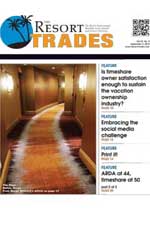How Airlines are Beating the Challenge of Online Travel Agencies … and Why Timeshares Should Pay Attention
Monday, September 30, 2013
The following article appears in the October issue of The Resort Trades. We are very appreciative of their permission to share this article with you.
How Airlines are Beating the Challenge of Online Travel Agencies … and Why Timeshares Should Pay Attention
by Jason Tremblay
Less than twelve months ago, online travel agencies (OTAs) set the standard for bookings in the travel and vacation industry. In an article published this past February here in The Resort Trades, (“The gnome has a message for you”) we looked at the triple-threat OTAs present, offering easy online booking, one-stop shopping for travel services, and discounted prices on accommodations, rental cars and airfares. How, we wondered, could the timeshare industry, the airlines or any other travel service provider compete for bookings in a space where OTAs seemed to wield so many advantages in addition to being fortified by deep pockets and low overhead?
In 2011, according to travel research firm, PhoCusWright, 37 percent of travelers booked their flights through an OTA, while 34 percent went directly to the air carrier’s website to book. Today the percentages are reversed, with branded websites for air carriers surpassing OTAs. Apparently, the airline industry had a strategy well underway to level the playing field and even to regain the advantage.
Why is this three to four point gain such a big deal? The big deal lies in the fact that this seemingly minor shift represents a 7-point swing. It is what PhoCusWright describes as an “epic behavior” change in the metrics of consumer buying patterns.
With airlines recognizing that they were balanced precariously on the edge of a looming abyss, in which their own bookings were being cannibalized by the OTAs, many large and small carriers alike, began working aggressively to educe change. They started pouring more dollars into advertising and marketing and adding loyalty perks and incentives that were available only to passengers who booked air travel on the carrier’s website. As Rick Seaney, chief executive of comparison site Farecompare.com points out, “It’s simple math. If it costs you, the airline, $16 to sell a ticket somewhere else, and $2 on your own site, you have some money to play with.”
Airlines cannot afford to let Expedia, Travelocity, or any of the other OTAs become the only touch point for travelers; doing so would cost them their brand identity and ultimately their business. In an industry that inherently lives on the brink of profitability, air carriers have had no choice except to reestablish themselves as the primary site for market engagement.
Airlines operate on extremely thin margins, weighted down by high fixed costs. Every day an airline operates, it aces two challenging wildcards: the fluctuating cost of fuel, which accounts for more than 30 percent of its operating costs, and the unpredictability of the weather.
An airline calculates the value of your body in its seat at an industry high that might reach $4.00 and a low that is barely more than a dollar. According to an analysis by Oliver Wyman for the Wall Street Journal, airlines make only $164 for every $16,400 they spend on the typical domestic flight.
OTAs, on the other hand, don’t have to fly the planes; they merely need to sell the tickets. Nor do they have to build and maintain hotels or timeshare resorts. They can spend a lot of money attracting vacationers to their websites, the kind of dollars that airlines, hotels and the vacation ownership developers simply do not have in their operational models.
The 2011 white paper, “Breaking the Hotel Addiction to OTAs: a 3-Step Recovery Plan,” authored by Madigan Pratt & Associates, points out, that although OTAs can be “a valuable marketing and third-party distribution resource for hotels,” they can also be, “hazardous to the health of your hotel.” In “A Call to Arms: How to Shift Market Share from the OTAs to the Hotel Website,” (written by Max Starkov and published this past spring by HeBS digital) 2013 has been defined as the “Year of Realizing the Extent of the Pain Caused by the OTAs.”
Both reports urge hoteliers to strengthen relationship building with their guests and to fortify their brands through disciplined direct and database marketing. Above all else, the message to anyone who wants to compete and win against OTAs is to make your website user experience exemplary through sites that target desktop users, mobile users and tablet users as three distinct markets.
In short, hoteliers are being counseled to beat OTAs at their own game. And in view of the success that airlines have already demonstrated in creating “epic behavior” changes in consumer patterns–despite the tightest of profitability margins–this strategy is a strategic plan well-scripted for timeshare resorts and hotels.
- Although OTAs come to the table with much strength, they do have their weaknesses—many of which are becoming increasingly more evident.
- OTAs are limited in their capacity to provide personalized customer service. They can rarely make exceptions to any of their rules, no matter how extenuating the customer’s situation. Their hands are tied when it comes to refunds.
- Currently, OTAs are busy gobbling up one another. While some will become larger (although not necessarily stronger), at least their numbers are being reduced.
- In the U.S. as well as other countries, including France, Germany, and Switzerland, OTAs are facing various anti-trust issues. Consumer groups and other watchdogs are questioning the legality and ethics of OTAs that block hotels from offering lower rates through other reservation services.
- Across the U.S., OTA’s are being brought up on tax issues. These are primarily lodging and occupancy taxes that are in many cases made much worse by penalties and interests reaching back as far as ten years. Win or lose, such lawsuits are time and energy draining for any company. In the event the OTAs do lose, judgments against many companies could run in the hundreds of millions of dollars on a case-by-case basis.
If ever there was a time for timeshare resorts, resellers and brands to reposition themselves as the go-to resource for booking travel accommodations, 2013 is turning out to be the year. Timeshare and vacation ownership brands should not hesitate to take their cue from the airlines, limiting the inventory they share with online travel agencies and upping their game, their marketing, their engagement and their brand benefits. In the end, timeshares are real places and real people, offering amazing vacation values and experiences. Just don’t expect those gnomes to go away without a fight. This competition is far from over.





